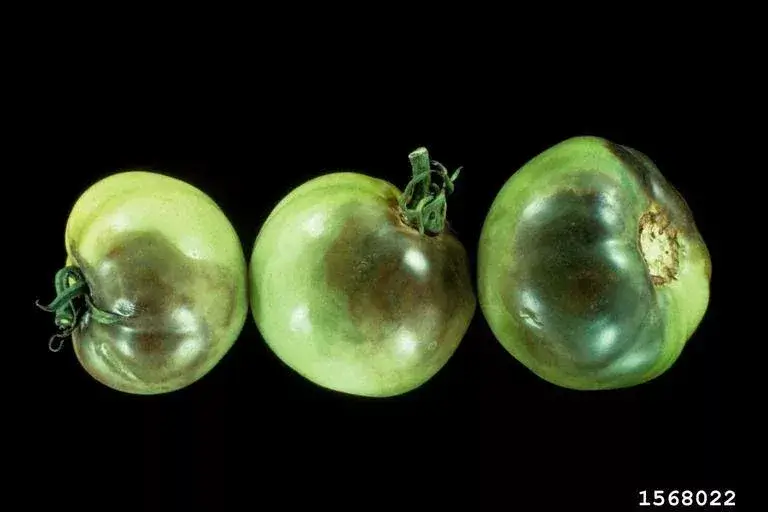
Late blight (Phytophythora infestans) is a disease that affects the stem, leaves, fruits, and tubers of potato and tomato crops. The disease was first discovered in the United States in the early 1840s where it caused devastation to many crop yields. Late blight is also responsible for causing the Irish potato famine in 1845. Phytophythora infestans is an oomycete pathogen. In other words, it shares similar superficial characteristics with fungi, such as reproduction using spores produced in sporangia, but it is actually more closely related to brown algae.

Phytophythora infestans (late blight) grows and reproduces rapidly on host crops such as tomatoes and potatoes, but may be found on other plant species as well. In the United States, there have been occurrences on hairy nightshade (Solanum sarachiodes), bittersweet (Solanum dulcamara), and petunias (Petunia hybride). Typically, environments with high moisture and moderate temperatures (60° and 80° F) are ideal for rapid reproduction.
Late bight can survive from season to season by living in infected potato tubers. Under favorable conditions, the pathogen may produce millions of spores that may spread in the air by wind or through the soil in wet conditions. The disease may further be spread by infected seed potatoes, growths from previously diseases potatoes that were not harvested in the previous year, cull and compost piles, and also plant transplants from one field to another.
It is very important to identity and control late blight. The disease is capable of wiping out entire crops even in commercial sized fields if the conditions are favorable. Not only will potato and tomato yields decrease in a given year, but infected tubers could reside in the soil to infect future crops if not managed properly. Late blight can have a large economic impact on a community through loss of tomato and potato yields, increased unemployment, as well as through the cost of control. A study by Guenthner et al. (2001) estimated the late blight cost to US growers to be over $287 million or $507 per hectare taking into account yield decrease, storage loss, decline in quality, price adjustment, and fungicide use. Additionally, fungicide application requires the use of machinery, which increases the amount of fuel needed. From an environmental standpoint, this may lead to decreases in energy supplies and increased pollution of the air and water (Haverkort et al. 2008).

Purple-brown lesions may occur on the surface of a tuber. If cut, the tuber will have rotted tissue that extends approximately one inch into the tuber and will appear reddish-brown. Observing symptoms may become difficult if the tuber, which was previously infected by late blight, becomes invaded from a second source, such as bacteria.
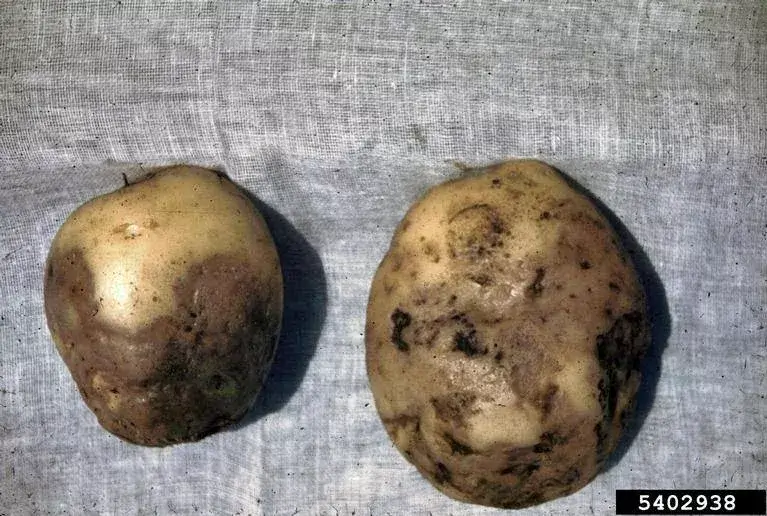
After wet periods, black, water-soaked lesions on leaves may be noticed within a week after becoming infected. Whitish growths (spores and sporangia) may be seen in humid conditions at the edges of the lesion, but once the lesion dries and turns brown, the spores will not be visible.
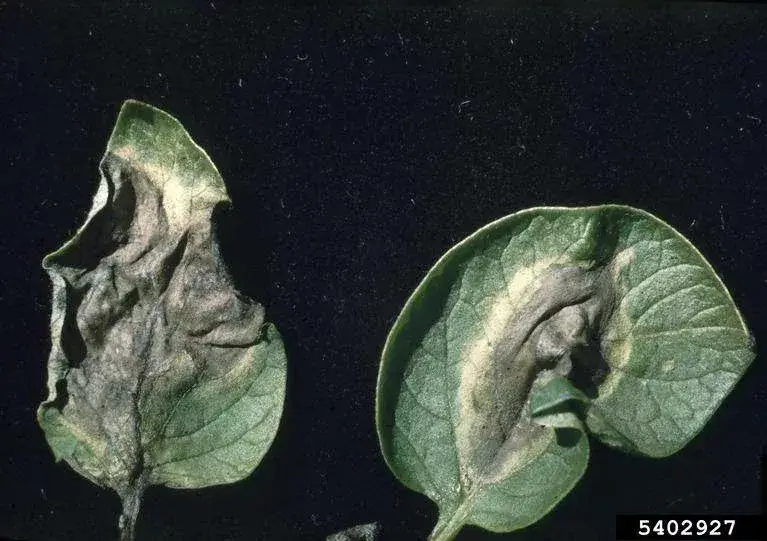
Stems of infected potato plants may have brown, greasy lesions. Stem lesions are frequently found at the junctions between the steam and a leaf, or at the top of a stem near clusters of leaves.
Lesions that occur on the stem and leaves of tomato plants will look similar to lesions found on potato plants. The fruit of tomatoes however, will have greasy circular lesion that may eventually become leathery and dark brown that take over the entire fruit. Spore producing structures may be present under humid conditions.
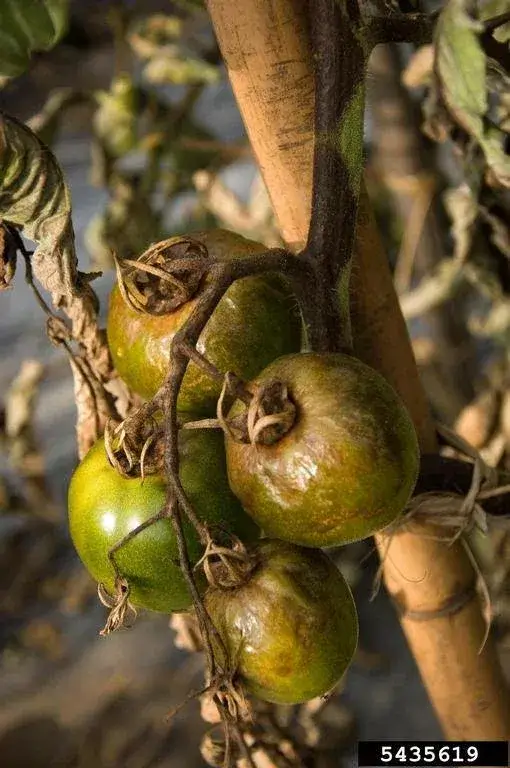
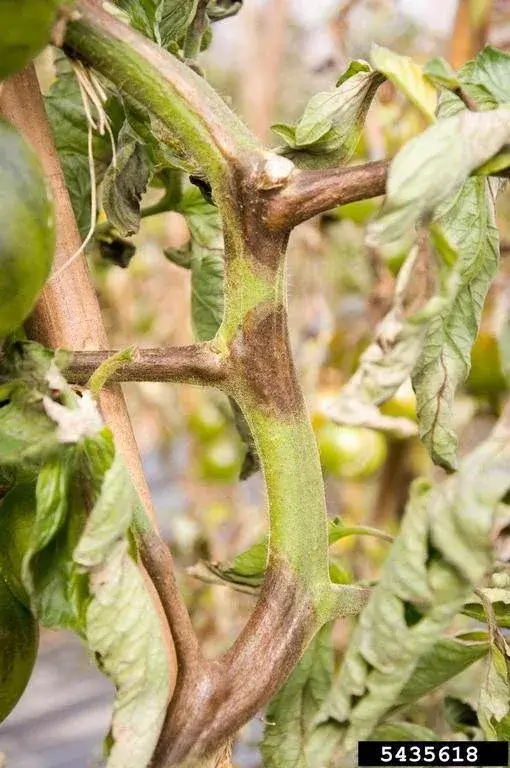
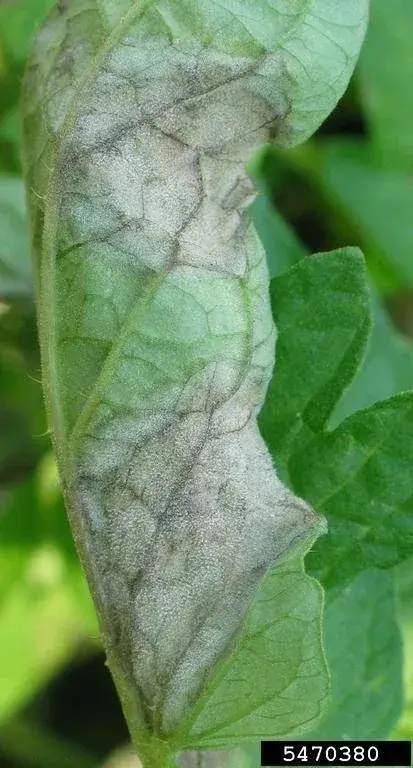

If you are unsure if the plant is infected by late blight, placing suspected infected leaves in a moist chamber overnight may produce the whitish sporangia.
There are some plant pathogens that look like late blight. If you are unsure if what you are dealing with is late blight contact your local Cornell Cooperative Extension or submit the plant to a diagnostic clinic for identification. Some common late blight look-a-likes include:
• Gray Mold: Late blight occurs in living tissue whereas gray mold will first establish itself in dead plant tissue. Growth will be fuzzier and gray or brownish (not white). Affected fruit will soften, but not brown.
• Drought stress: Occurs when part of the leaf tissue browns at leaf edges when dying from lack of water. No fuzzy pathogen growth.
• Early blight: Spots on all parts of the plant are smaller than late blight, which has concentric ring patterns in them.
• Septoria leaf spot: Smaller leaf and stem spots than late blight with a tan center. Fruits are not affected.
• Buckeye fruit rot: Leaves and stems are not affected. Affects fruit (usually those close to soil) by turning them brown with white spores forming. Fruit stays firm and smooth.

It is best to try and avoid sources of spores early in the season. Only plant healthy certified seed potatoes as well as avoid any transplants or imported fruit that could have come in contact with the disease. Before planting, make sure to examine the seed and only plant those that are healthy and blemish free. Unhealthy, potentially infected seed and plants should be destroyed or made sure to be completely decomposed. If you had previously infected plants last season, make sure to remove all new growth. To prevent spores in the soil from infecting the potato tubers, you can hill up the soil around the plant base. Also, vines should be dead or cut above the soil surface 2-3 weeks before harvesting.
There are some potato and tomato varieties that are showing some resistance to late blight (Chen et al. 2003). Planting these may be an alternative to slow down the spread of late blight, but may not necessarily prevent the disease from occurring. To decrease the impact of late blight on communities, researchers are further investigating genetic modification of potatoes to decrease susceptibility to late blight (Haverkort et al. 2008).
If it is known that late blight is in your area and the growing season is wet, there are fungicides that may help protect your plants. These need to be applied before coming in contact with the disease. Late blight can infect plants at any time during the growing season, so continual application of the fungicide may be needed. Fungicides with maneb, mancozeb, chlorothalonil, or fixed copper and has tomato and potato late blight on the label could be used. There are concerns that overuse of fungicides may lead to the evolution of pesticide resistance within late blight. It is best to contact your local Cornell Cooperative Extension for more information about how to use pesticides and which ones are approved organic before using them. As always, it is important to read the instructions on the label and use the pesticides accordingly.
It is recommended to inspect plants every week for symptoms. If you experience an outbreak or know of local occurrences, it is also best to inform and educate neighboring growers.

As part of prevention of late blight, it is important to stay up-to-date on where late blight has already occurred by checking out www.usablight.org/map
Fry, William. 1998. Late Blight of Potatoes and Tomatoes. Vegetatioble Crops. Fact Sheet 726.20. Integrated Pest Management. Cornell University. 5 pages.
Hallee, Neal. Guidelines for commercial composting of cull potatoes. University of Maine Cooperative Extension. Bulletin 2415. 4 Pages.
Late Blight: A Serious Disease of Potatoes and Tomatoes. New York Integrated Pest Management Program. Cornell Cooperative Extension. 6 panel, tri-fold brochure.
